Noble Rot in Winemaking [Botrytis Wine Explained]
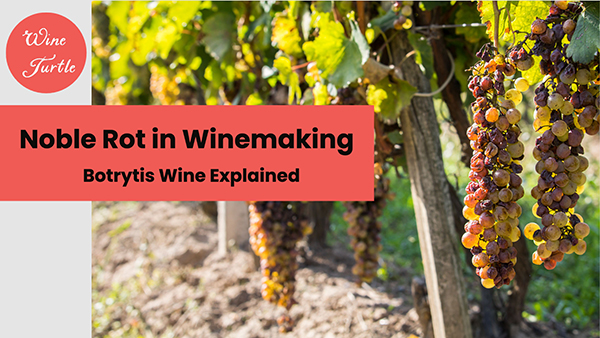
Wait, rotten grapes you say? No thanks!
I know that was my first reaction to hearing about noble rot in winemaking.
But, it's a story worth hearing and the wines are most definitely worth tasting!
Learn all about the treasured fungus in today's deep dive.
What is 'Noble Rot'?
Noble rot, or 'Botrytis cinerea' as the scientists would have it, is a term that seems paradoxical – an unlikely marriage of the grand and the decrepit.
Yet, in the enigmatic world of wine, it is often such contradictions that yield the most delightful surprises.
Noble rot is a fungus that affects grapes, causing them to become dehydrated and concentrated with sugar.
But it's not your run-of-the-mill, destructive type of fungus.
It's more of a capricious fairy godmother, choosing to bestow its gifts only under the most particular conditions.
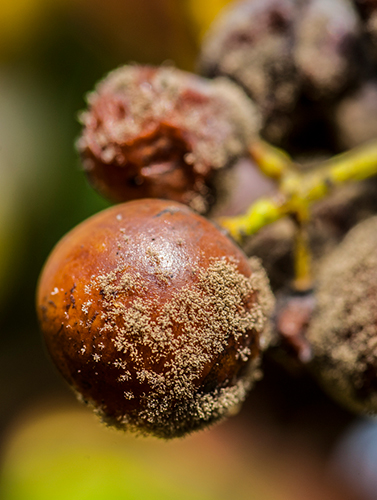
Noble rot close up
When the morning mists and warm, sunny afternoons of late autumn conspire to create the perfect humidity, Botrytis descends upon vineyards, casting a spell of transformation over the grapes.
This magic is, in fact, dehydration. The fungus punctures the grape skins, allowing water to evaporate and leaving behind a higher concentration of sugars and acids.
The result?
Grapes that are shrivelled and unappetising to look at, but which possess an intensified, honeyed sweetness and a complex acidity – the makings of some of the world's most celebrated sweet wines.
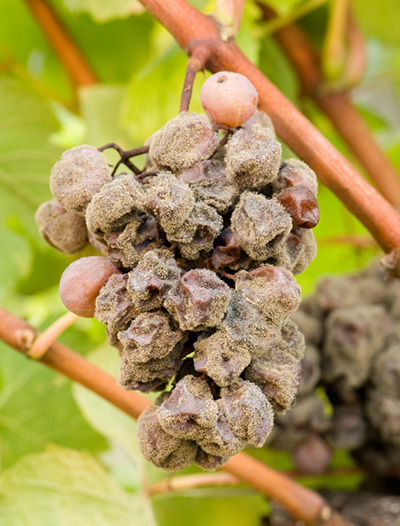
Botrytised Grapes
The best known of these is perhaps Sauternes, from the Bordeaux region of France, where the noble Semillon grape often plays the leading role, ably supported by Sauvignon Blanc and Muscadelle.
But Botrytis isn't a respecter of borders. It has worked its magic in the vineyards of Germany and Austria, where it contributes to the creation of Beerenauslese and Trockenbeerenauslese wines, the pinnacle of Riesling expression.
The art of making botrytized wine is a delicate balancing act. Vintners must keep a watchful eye on their vineyards, ready to harvest at just the right moment when the rot has worked its magic but before it tips over into destructive decay.
It's a labour-intensive process, but the resulting wines – with their luscious sweetness, balanced acidity, and complex flavours of honey, dried fruit, and spice – are considered well worth the effort.
The Science of Noble Rot
The Botrytis cinerea fungus is responsible for the unique flavor profile and high sugar concentration found in noble rot wines.
Understanding the science behind noble rot is crucial to understanding its importance in winemaking.
Definition of Botrytis cinerea
Botrytis cinerea is a necrotrophic fungus that affects many plant species. It's highly versatile and ubiquitous, notorious for its dual nature.
On the one hand, it can ruin crops by causing a condition known as grey rot; on the other, under specific conditions, it can induce noble rot, a desirable phenomenon in viticulture that leads to some of the world's most exquisite sweet wines.
Let's be clear, the rot that Botrytis cinerea inflicts on plants is usually an unwanted disease. It's only in the production of certain wines that this fungus is encouraged to grow.
1. Life cycle of Botrytis cinerea
The life cycle of Botrytis cinerea is a dance between survival and propagation, underpinned by its ability to adapt to different environmental conditions.
During the growing season, the fungus exists as mycelium, a network of filaments that live in dead or decaying plant material. Under humid conditions, the mycelium produces spore-bearing structures known as conidiophores, which release airborne spores called conidia.
These conidia are carried by the wind to the surfaces of plants, where they germinate and penetrate the plant tissue under moist conditions.
Once inside the plant, the fungus proliferates, killing the cells and extracting nutrients to fuel its growth. As the plant tissue decays, the fungus produces more mycelium and conidia, completing the cycle.
During the winter or in unfavorable conditions, Botrytis cinerea produces sclerotia – compact masses of hardened mycelium – that can survive in the soil or plant debris.
When conditions become favorable again, the sclerotia germinate to produce mycelium or fruiting bodies, starting a new cycle of infection.
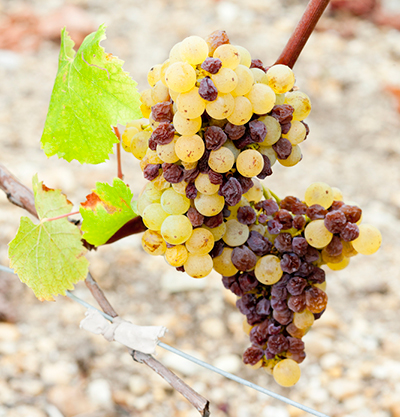
White grapes in Sauternes
2. How Botrytis cinerea affects grapes
The effect of Botrytis cinerea on grapes is a tale of two outcomes: one devastating, the other desirable.
In damp, cool conditions, the fungus causes grey rot, a destructive disease that can decimate grape crops. Infected grapes turn brown and shrivel, often covered with a fuzzy grey mold.
But in the serendipitous interplay of morning mists and warm afternoons, typically in late autumn, Botrytis cinerea can bring about noble rot.
The fungus perforates the grape skins, causing water to evaporate and thereby concentrating the sugars and acids within. The affected grapes look shriveled and unappetizing, but they yield intensely sweet and complex flavors when turned into wine.
This dual effect is why Botrytis cinerea is both feared and revered in vineyards around the world. The chance to create a botrytized wine is a high-stakes game for winemakers, requiring precise timing to harness the beneficial effects of the fungus without letting it tip into destructive decay.
The result, when successful, is sweet wines of remarkable depth and complexity, a testament to the capricious wonders of nature.
Chemical Changes in Grapes During Noble Rot
The chemical changes that occur in grapes during noble rot are what make these wines so special.
The high sugar concentration and unique flavor profile are a result of the fungus's interaction with the grape.
1. Sugar Concentration
The noble rot process begins when Botrytis cinerea perforates the skin of the grape. This causes water to evaporate, and the grape begins to shrivel like a raisin.
With the water volume decreasing, the grape's sugar content becomes increasingly concentrated. The result is a much sweeter grape ready for the production of sweet wines like Sauternes, Tokaji, or Trockenbeerenauslese.
The sugar concentration also leads to a higher potential alcohol content in these wines, although the fermentation often stops before all the sugar is converted, leaving a high level of residual sugar in the finished wine.
The sugars also contribute to the wine's viscosity and mouthfeel.
2. Flavor Profile
Botrytis cinerea influences the flavor profile of the grape in a unique way. As the fungus feeds on the grape, it breaks down and modifies the grape's acids, phenolic compounds, and other flavor precursors, creating new compounds that add complexity to the resulting wine.
The concentration of the sugars and acids in the grape due to water evaporation can also amplify the fruit flavors, leading to the characteristic rich and honeyed taste of botrytized wines.
These flavors are balanced by a high acidity level, which gives the wine a bright, refreshing finish.
3. Aroma Profile
The noble rot fungus produces a range of metabolites as it feeds on the grape, and these contribute to the distinctive aroma profile of botrytized wines.
The most significant of these is glycerol, which gives the wine a rich, unctuous mouthfeel and a characteristic honeyed aroma.
Other compounds, including phenols and lactic acid, contribute to the complex aromas often described as beeswax, gingerbread, saffron, and other exotic and spicy notes. The concentrated fruit flavors can also lead to intense fruit and floral aromas.
The precise nature of the aroma profile can vary depending on the grape variety and the conditions in the vineyard, but it's always marked by a unique depth and complexity that sets botrytized wines apart.
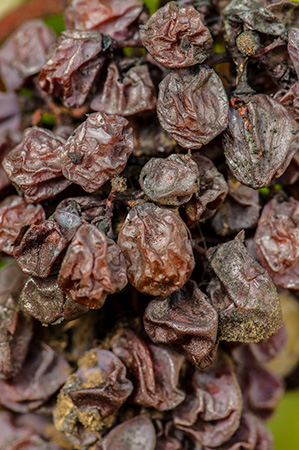
The History of Noble Rot
To appreciate the history of noble rot, we must first acknowledge the role of serendipity. The very concept of a rot being 'noble' seems counterintuitive, especially in an industry that cherishes careful cultivation and control.
The initial discovery of noble rot was likely due to a fortuitous accident, where a seemingly ruined harvest yielded unexpectedly sweet and complex wines.
The first wines intentionally made from botrytis-infected grapes can be traced back to Hungary in the 17th century. The story goes that during the 1650s, in fear of an impending Turkish attack, harvest was delayed in the Tokaji region.
When the grapes were finally collected, they were affected by botrytis. The result was the birth of Tokaji Aszú, a wine revered for its sweetness and depth.
Meanwhile, in France, the first Sauternes, a wine that would become synonymous with noble rot, were produced in the late 18th century.
The production of these wines was a delicate dance between risk and reward. With the right balance, botrytis cinerea could concentrate the sugars and flavours in the grapes, leading to a wine of unparalleled richness and complexity. But if conditions weren’t just right, the entire harvest could be lost.
In Germany, the tradition of sweet, botrytised Riesling wines began in the 18th century. Legend has it that in 1775, the harvest at Schloss Johannisberg in the Rheingau was delayed by several weeks due to a clerical error, resulting in the first intentional production of a Beerenauslese style wine.
The spread of noble rot to the New World followed the path of European immigrants who brought their winemaking traditions with them. This serendipitous fungus found its way to vineyards in Australia, New Zealand, South Africa, and the United States, where it continued to transform grapes into golden elixirs.
Notably, in the late 20th century, Napa Valley's Dolce Winery gained acclaim for its botrytis-infected late harvest wine, showing that the New World could indeed compete with the Old in this unique category.
Where are Botrytized Wines Made?
Noble rot is used in several wine regions around the world to produce some of the most highly prized sweet wines.
These regions typically have specific climatic conditions that promote the growth of the fungus in a beneficial way. Here are a few notable examples:
Noble Rot and Terroir
Terroir, the unique combination of environmental factors that affect grape growth, plays a significant role in the development of noble rot in grapes.
Two of the most critical factors are climate and soil composition.
1. Climate
Noble rot thrives in specific conditions that can seem paradoxical at first glance. It needs an initial period of wet or humid conditions to germinate on the ripe grapes, followed by drier conditions to prevent the development of destructive grey rot.
The initial humidity allows the botrytis fungus to infect the grape, which usually happens in the early morning when mist or fog rolls over the vineyards.
This is why regions near bodies of water, such as the Sauternes region in Bordeaux with its proximity to the Ciron river, are prime real estate for botrytis-prone vineyards. The cool morning mists from the river provide the necessary moisture.
Following this, what we need is a swift change to drier, warmer conditions. These conditions allow the botrytis to develop into 'noble rot', causing the water inside the grape to evaporate, concentrating the sugars and flavors.
This dryness is crucial - too much continued dampness, and we veer into the territory of 'grey rot', the destructive cousin of noble rot that can ruin entire harvests.
This rhythm of morning moisture followed by warm, dry afternoons is the heartbeat of noble rot development. It's a delicate, natural ballet that needs to be followed closely and requires a touch of viticultural intuition, a dash of luck, and an immense amount of patience.
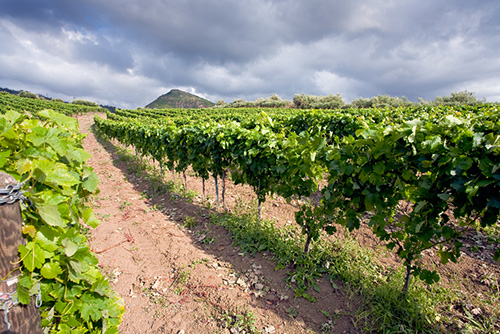
2. Soil Composition
The soil must possess a good capacity for retaining moisture to provide the initial damp conditions that the fungus favors for germination.
At the same time, it should be well-draining enough to avoid waterlogging, which can promote detrimental forms of rot and disease.
Soils with a high proportion of clay, for instance, are excellent at retaining moisture and are often found in regions known for noble rot wines.
But this is only part of the story.
The soils in these regions are typically complex and layered, with gravel or limestone subsoils that ensure good drainage.
The vineyards of Sauternes, for example, are blessed with a soil composition of gravel over a clay subsoil. The gravelly topsoil retains the heat of the day, which assists in the evaporation process essential for noble rot to work its magic. The clay underneath, meanwhile, retains sufficient moisture to encourage the initial development of the botrytis fungus.
Another good example is the Tokaji region in Hungary, renowned for its botrytis-affected wines.
Here, the volcanic soil, rich in minerals, provides excellent drainage while also retaining enough moisture to encourage the growth of the fungus.
Examples of Terroir Affecting Noble Rot Wines
Sauternes
Here, the warm, humid microclimate caused by the meeting of the Ciron and Garonne rivers provides the perfect conditions for the botrytis fungus to develop.
The region's gravelly soil with a clay subsoil retains the heat of the day, aiding in the evaporation process.
The wines produced here, such as the iconic Château d'Yquem, are renowned for their rich, luscious character, with flavors of apricot, honey, and a distinct nuttiness, balanced by a vibrant acidity.
Tokaj vs. Other Regions
Tokaj, Hungary is another region that is known for its sweet, botrytized wines. The terroir in Tokaj is unique, with volcanic soil that is rich in minerals and a climate that is ideal for the development of noble rot.
Compared to other regions that produce sweet wines, such as Sauternes and the Rhone Valley, Tokaji Aszú wines have a distinct flavor profile that reflects the unique terroir of the region.
Tokaji Aszú wines are known for their complex flavors of honey, orange peel, and spice, which are a result of the volcanic soil and unique climate of the region.
Noble Rot and the Environment
Noble rot is not only affected by winemaking techniques and terroir, but also by environmental factors such as climate change and the use of pesticides and fungicides.
These factors can have a significant impact on the production and quality of noble rot wines.
Impact of Climate Change on Noble Rot
For the botrytis fungus to take hold, grapes need a period of dampness or high humidity followed by drier conditions.
These conditions typically occur in the autumn in regions like Sauternes in Bordeaux, Tokaji in Hungary, and the Neusiedlersee in Austria.
However, with climate change, these conditions are becoming less predictable. Warmer temperatures are leading to earlier ripening of grapes, which could potentially occur before the autumn mists roll in, crucial for the development of noble rot.
Moreover, too much heat can stress the vines and lead to lower acidity levels in the grapes, which is critical for balancing the high sugar concentration in noble rot wines.
On the other hand, if rains become too heavy or frequent, the noble rot can turn into grey rot, which is detrimental to the grapes.
Furthermore, extreme weather events, such as hailstorms, can severely damage the delicate botrytised berries.
Adaptation strategies are being explored, including experimenting with different grape varieties, adjusting vineyard management techniques, and even considering relocation of vineyards to areas with more suitable future climates.
Effects of Pesticides and Fungicides on Noble Rot
Pesticides and fungicides are commonly used in conventional grape farming to prevent diseases and pests, including Botrytis cinerea.
However, the use of these chemicals can have a negative impact on the development of noble rot, as they can kill off the beneficial microorganisms that contribute to the formation of noble rot.
The use of pesticides and fungicides can also have environmental consequences, such as soil degradation, water pollution, and harm to wildlife.
Therefore, many winemakers have been exploring alternative methods of pest and disease control, such as integrated pest management and organic farming, which can promote the natural balance of the vineyard ecosystem and preserve the quality of noble rot wines.
Efforts to Preserve Noble Rot
Winemakers and researchers are implementing various strategies to preserve the production of noble rot wines amid shifting climatic conditions.
Here are some of the most notable efforts:
- 1Vineyard Management Techniques: Through altering traditional vineyard management techniques, winemakers can better adapt to changing climate conditions. For instance, changing the training system of the vines, the timing of pruning, or the use of canopy management techniques can help to maintain the delicate balance needed for noble rot to develop.
- 2Research and Development: Enology and viticulture research institutions are actively studying the impact of climate change on noble rot. This includes researching the biology of Botrytis cinerea, the fungus responsible for noble rot, to understand how it may adapt to changing climates.
- 3Experimentation with New Varieties: Some winemakers are experimenting with different grape varieties that may be better suited to warmer climates or that have a natural affinity for noble rot. This could help to ensure the continued production of these unique wines, even if the traditional grape varieties used become less viable.
- 4Terroir Exploration: As climate change shifts the traditional wine-growing regions, winemakers are exploring new areas where conditions might be more suitable for the development of noble rot in the future.
- 5Advocacy and Policy: On a broader level, winemakers and wine industry organizations are advocating for policies to combat climate change. This includes promoting sustainable practices in the vineyard and winery, advocating for renewable energy, and supporting policies that aim to reduce greenhouse gas emissions.
Food Pairings with Noble Rot Wines
Noble rot wines are known for their unique sweetness, acidity, and flavor profile that make them a perfect pairing for certain foods.
The sweetness level of noble rot wines is high, but it is balanced by their high acidity, which adds a refreshing and crisp note to the wine.
The flavor profile of noble rot wines is complex and unique, with notes of honey, apricot, and tropical fruits.
Here are some of the best food pairings for these wonderful wines.
Noble rot is a testament to the complexity and diversity of the world of wine.
Its importance in winemaking and rich history make it a topic worth exploring and appreciating.
As wine enthusiasts, we should continue to celebrate and preserve the unique qualities of noble rot wines for generations to come.
